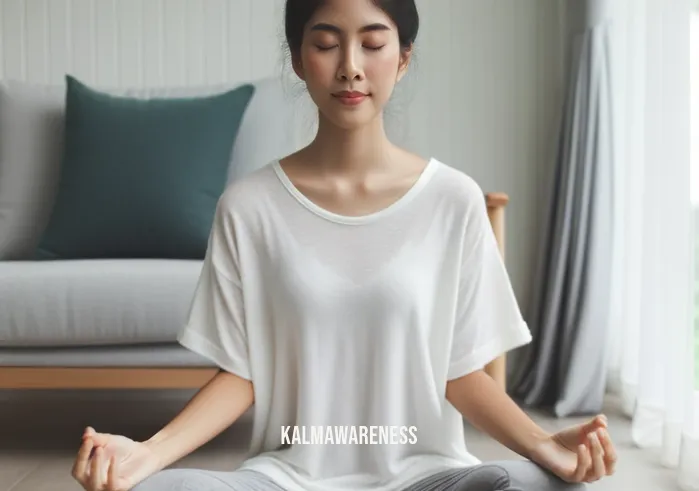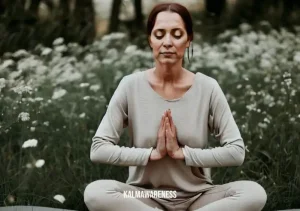Embracing the Zen of “Head Empty, No Thoughts”
Have you ever felt overwhelmed by the constant buzz of thoughts in your mind, longing for a moment of peace and clarity? Welcome to the world of “head empty, no thoughts,” a state many of us dream about but often find elusive. It’s not about shutting down your brain; it’s about finding a serene space within the chaos of everyday life.
The Allure of Mental Quietude
In our hyper-connected world, our minds are bombarded with information, responsibilities, and endless to-do lists. This mental clutter can be exhausting. Achieving a state of ‘head empty, no thoughts’ is like giving your mind a much-needed vacation. It’s about reaching a point where your thoughts don’t control you – you control them.
A Journey Through Mindfulness and Meditation
Mindfulness and meditation are key players in this journey. It’s not about forcing your mind to be blank but rather about observing your thoughts without judgment. It’s like watching clouds drift across the sky. You notice them, acknowledge them, but don’t get caught up in them. For insights into mindfulness and its transformative power, check out Mindful Muscle and Meditation in Motion.
The Science Behind the Stillness
It might sound like a new-age concept, but there’s solid science backing the benefits of mental stillness. Studies show that practices leading to this state can reduce stress, enhance focus, and even improve physical health. The brain, when relieved of constant thinking, switches gears to a more creative, relaxed state. For more on this, the article Meditation Stories for Students provides some fascinating insights.
Tackling the Habitual Thinking Loop
Our minds are wired for constant thought – it’s a survival mechanism. But in our modern world, this often translates to stress and anxiety. Breaking this cycle requires practice and patience. Understanding habitual thinking is a good start; Habitual Thinking: Definition offers a deeper understanding of this concept.
A Practical Approach to Emptiness
Achieving a ‘head empty, no thoughts’ state isn’t about renouncing your responsibilities or escaping reality. It’s about finding moments of stillness amid the hustle. Simple practices like focused breathing, short meditative sessions, or even mindful walking can be gateways to this state. Resources like Mindful Hiking can guide you on starting these practices.
From Theory to Practice
It’s one thing to understand the concept of ‘head empty, no thoughts’ and another to implement it in your daily life. Start small – dedicate a few minutes each day to sit in silence, focus on your breath, or take a mindful walk. Let these moments be your daily mini-vacations from the hustle of life.
As we conclude this section, consider this: What small step can you take today to move closer to experiencing the tranquility of ‘head empty, no thoughts’? This question isn’t just rhetorical; it’s a stepping stone to our next exploration in this journey. Stay tuned for more insights and practical tips on how to make ‘head empty, no thoughts’ a reachable reality in your life.

Navigating the Path to Inner Silence
In the pursuit of ‘head empty, no thoughts,’ it’s important to understand that this state isn’t about a void of thinking but rather about achieving a peaceful coexistence with your thoughts. Let’s delve deeper into how we can navigate our way to this tranquil mental space.
The Role of Mindful Practices
Beyond Basic Meditation
While meditation is a cornerstone in achieving mental stillness, it’s not the only path. Exploring various forms of mindful practices can be remarkably effective. This could include activities like yoga, tai chi, or even mindful cooking. These practices help in grounding your thoughts and bringing you to the present moment. For a deeper understanding of these practices, Ancient African Meditation Techniques offers some unique insights.
The Power of Mindful Movement
Mindful movement practices like yoga or tai chi serve a dual purpose. They not only help in physical wellness but also in calming the mind. This is where the body and mind connect, creating a harmony that leads to a state of ‘head empty, no thoughts.’ Mindful Martial Arts is an excellent resource for exploring how movement can be a form of meditation.
Understanding and Overcoming Mental Chatter
Our minds are naturally inclined to think, analyze, and often overthink. Understanding the nature of this mental chatter is crucial in learning how to manage it.
Identifying Triggers and Patterns
Recognizing what triggers your mental chatter and the patterns it follows can be enlightening. Is it stress, anxiety, or external stimuli that set your thoughts racing? Understanding these triggers can help you in devising strategies to calm your mind.
Strategies for Quieting the Mind
| Strategy | Description | Benefit |
|---|---|---|
| Focused Breathing | Concentrating on your breath to anchor your thoughts. | Brings immediate mental calm. |
| Mindful Walking | Walking with awareness of each step and your surroundings. | Enhances connection with the present. |
| Short Meditation Sessions | Regular, brief periods of meditation throughout the day. | Builds mental discipline and focus. |
Integrating Mindfulness into Daily Life
It’s not just about dedicated practices; it’s also about integrating mindfulness into your daily activities. This could mean being fully present while eating, listening, or even during work. For tips on integrating mindfulness seamlessly into your routine, Mindful Skills is a valuable resource.
The Challenges Along the Way
Embracing Imperfection
It’s important to acknowledge that the journey to ‘head empty, no thoughts’ is not a linear one. There will be days filled with mental noise and days of profound quiet. Embracing this imperfection is part of the process.
Overcoming Discouragement
When progress seems slow or imperceptible, it’s easy to feel discouraged. Remember, every small step counts. The key is consistency and patience.
As we wrap up this section, consider these questions: How do your daily activities influence your mental chatter? What simple changes can you make to foster a more mindful lifestyle? These reflections are not just food for thought; they set the stage for our final section, where we’ll explore how to sustain and deepen the practice of ‘head empty, no thoughts’ in our daily lives. Stay with us as we uncover more in our concluding segment.

Cultivating a Mind of Stillness and Serenity
As we journey through the final stretch of our exploration into ‘head empty, no thoughts,’ let’s integrate our learnings and contemplate how to embed this tranquil state into the fabric of our daily lives. The key is not just in understanding but in applying these insights consistently and mindfully.
Making ‘Head Empty, No Thoughts’ a Daily Reality
Embracing Small Daily Practices
The foundation of achieving a ‘head empty, no thoughts’ state lies in the small, consistent practices we integrate into our daily routines. Whether it’s a few minutes of mindful breathing each morning, a short walk in nature, or practicing mindfulness during routine tasks, these small actions cumulatively create a significant impact on our mental state.
The Role of Mindful Reflection
Setting aside time for reflection can be a powerful tool in understanding our thought patterns. Reflective practices like journaling or even quiet contemplation can help us identify triggers and patterns in our thinking, enabling us to approach our thoughts with more awareness and control.
Future Applications and Scenarios
In the Workplace
Imagine a work environment where ‘head empty, no thoughts’ is not just a concept but a practice. Employees take short mindful breaks, leading to increased focus, creativity, and productivity. For those seeking to integrate mindfulness into their professional life, A Renewed Mind Employee Portal offers valuable resources.
In Education
Students learning to cultivate this state of mind can approach their studies with greater calm and concentration. Mindfulness techniques can be integrated into the curriculum, helping students manage stress and enhance their learning experience. Resources like Mindfulness Books for Teens can be instrumental in this regard.
In Personal Relationships
Practicing ‘head empty, no thoughts’ can lead to more present and meaningful interactions in personal relationships. It helps in listening actively and responding thoughtfully, fostering deeper connections.
Actionable Steps for Continued Growth
Explore Further Learning
Continued learning is key. Engage with books, articles, or courses on mindfulness and meditation. Websites like Penn Mindfulness Class offer courses that can deepen your understanding and practice.
Practice Regularly
Consistency is crucial. Make mindfulness a daily practice, even if it’s just for a few minutes each day.
Seek Community
Joining a community of like-minded individuals can provide support and motivation. Consider groups or classes that focus on mindfulness and meditation.
Final Thoughts and Reflections
As we conclude our exploration of ‘head empty, no thoughts,’ it’s important to remember that this journey is personal and unique for each individual. The path to achieving this state of mental tranquility is not always linear but is filled with learning and growth.
- Consistent Practice: Small, daily mindful practices can lead to significant mental clarity.
- Mindful Reflection: Regular reflection helps in understanding and managing our thought patterns.
- Application in Daily Life: Integrating mindfulness in work, education, and personal relationships enhances focus, learning, and connection.
- Continued Learning: Engaging with further resources and communities can deepen your mindfulness journey.
Let’s carry forward the insights and practices from this exploration into our daily lives, cultivating a mind that can experience tranquility amidst the chaos. Remember, the journey to ‘head empty, no thoughts’ is ongoing, filled with moments of learning and discovery.




